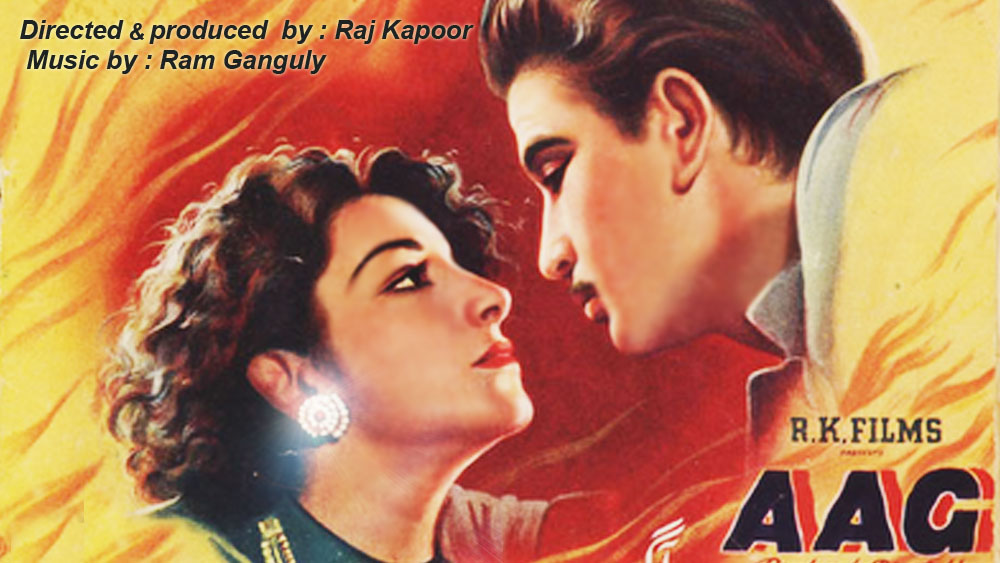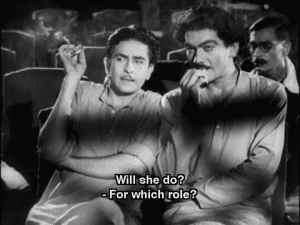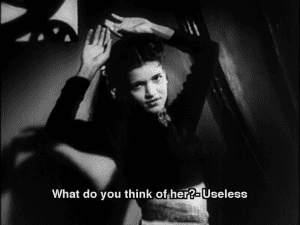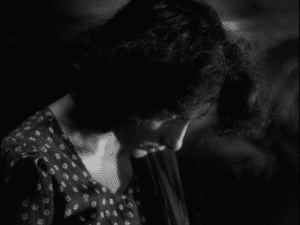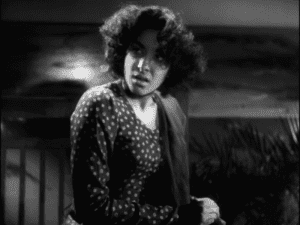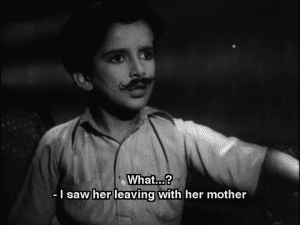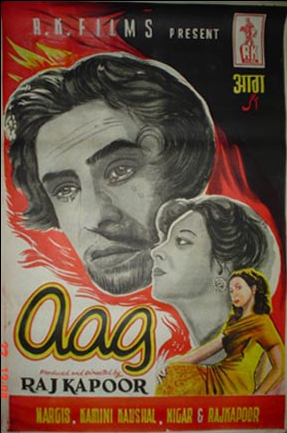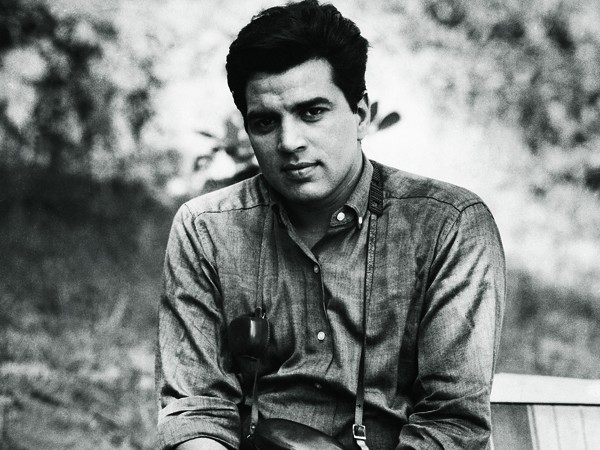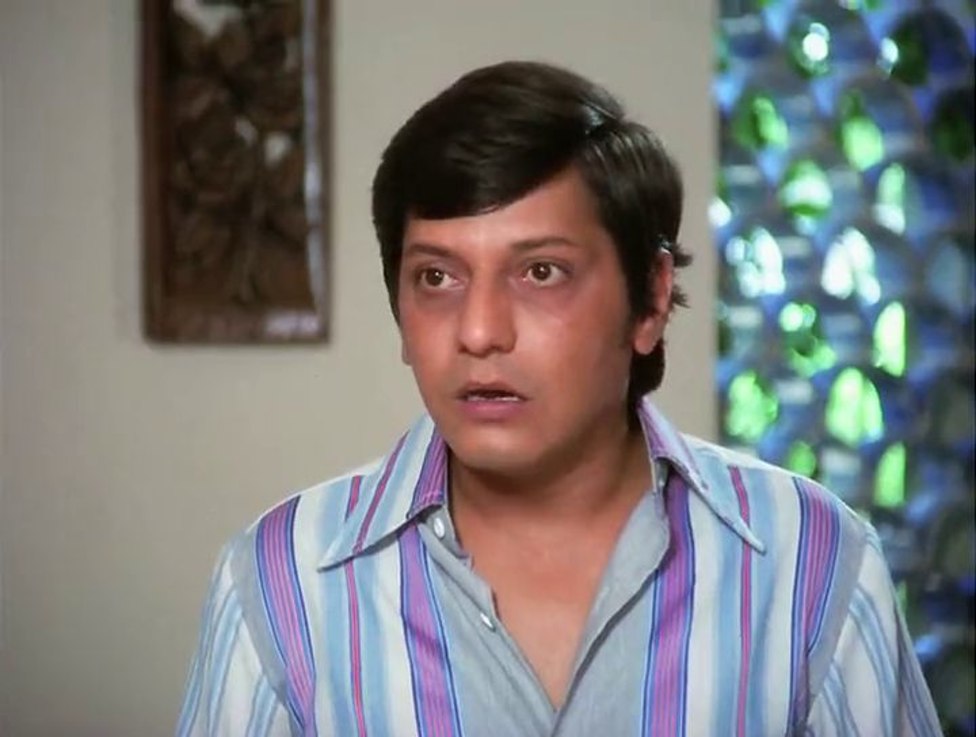Directed by Raj Kapoor
Produced by Raj Kapoor
Written by Inder Raj Anand
Starring Raj Kapoor, Nargis, Premnath
Music by Ram Ganguly
Release dates 6 August 1948
Running time 130 mins
Raj Kapoor’s Shree 420 is one of my all-time favorite movies. It strikes a marvelous balance between entertainment and message, between substance and spectacle. It took Kapoor a few tries to master that mix, however. Awara, a few years before Shree 420, is too dire, plodding, serious. And his first film as an auteur, Aag (“Fire”), misses the mark entirely. It is weak on substance and poor in entertainment, but loaded with pretension and dripping with self-importance.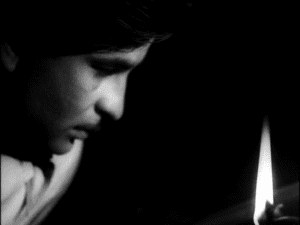
Aag tells the story of Keval Khanna (Raj Kapoor), a man gripped by two obsessions that trace to his childhood: a passion for the theater, and an idealized love for his childhood sweetheart, Nimmi. Both these obsessions stem from the same formative event; the young boy version of Keval (played deliciously by Shashi Kapoor) stages a play with Nimmi, complete with elaborate sets and other accouterments of a real theater. But on opening night, Nimmi never shows – her family has suddenly moved away from their village – and Keval is left heartbroken, without a heroine, laughed at by a packed house of mean, mocking children.
The grown Keval spends the rest of the movie trying to recreate this event and rectify his loss. He bucks his father’s expectation that he will study law and follow a conventional path, instead forging a life in theater and searching for his Nimmi. Keval works his way through several Nimmi candidates, molding each one in his mind to match the fantasy he has constructed of the girl he hasn’t seen since childhood. The first surrogate Nimmi, Keval’s college classmate Nirmala (Kamini Kaushal) abandons him just as his childhood Nimmi did, this time to engagement. Later, Keval meets a dejected woman (Nargis) who has lost her home to Partition. Eager to put that trauma in the past, the woman insists that she does not even have a name. (In Aag‘s favor, it is noteworthy that the rifts of Partition are already appearing in the movies, at a time when the wounds are still bleeding and fresh.)
Keval is taken with this sad, nameless woman, whom he, of course, dubs Nimmi, and stages a play around her. Keval’s business partner Rajan (Prem Nath), an artist, also sees in her the woman he has long dreamed of painting. This is the great art of Aag – two men each projecting their idealized fantasy onto this woman, so conveniently without the identity of her own to get in their way. The audition sequence in which Keval rejects a parade of women, one after another, with nothing more than a superficial glance, is bad enough. What is over-the-top just revolting is that the idealization of Nargis’s character by both men is presented as a triumph of art, rather than the despicable objectification and usurpation of a vulnerable woman’s independent existence.
Kapoor attempts to lend the movie some depth with a disjoint pair of bookends in which Keval, disfigured by the titular fire (which he sets in a fit of lunatic rage at the very idea that Nargis’s character might not be exactly the woman he has projected upon her), laments that he is hated for his ugliness as much as he used to be loved for his beauty. This Keval, incidentally, is not a modest man – his own supposed beauty is as much an obsession for him as his Nimmi. And what is with Kapoor’s fascination with beauty disfigured by flame? Between Aag and Satyam shivam sundaram, it seems this notion had special resonance for Raj Kapoor. At any rate, the scenes do not relate much to Keval’s twin passions that make up the rest of the film, and Aag is too far up its own ass for this tacked-on attempt at a message to be anything but flimsy.
If there are reasons to endure this festival of pretension, they are Nargis and little boy Shashi Kapoor. Nargis is simply wonderful with her wildly frizzy hair and wide-eyed beauty. It is such a long way from this unadorned natural gorgeousness to the meticulously styled and coiffed heroines one usually encounters in the movies. In one of Aag‘s rare charming details, Keval is often shown playing with an arrant lack of Nargis’s hair, smoothing the curls with his palm or twirling one around a finger. As striking as she is, though, the almost feral rawness of Nargis’s character leaves her that much more ripe for absorbing the identities that the two men construct for her.
As for proto-Shashi, some 9 years old when the film was shot, he is just plain adorable. He gets so many scenes of substance, from delight to inspiration to anxiety. When he sasses his mother, the cheeky mannerisms that made him an explosive charmer 20 years later are already on full display. One sequence in which the young Keval tries to sneak out of the house to watch a play, evading discovery by his intimidating father (Kamal Kapoor), is especially delightful.
The unfortunate fact, though, is that Aag plummets rapidly downhill about half an hour in, as soon as Shashi’s scenes are done. The movie might be worth sitting through for the cuteness of Shashi, the beauty of Nargis, some notable cinematography, and some lovely songs. But don’t expect the sparkle and immersive charm of Raj Kapoor’s best movies. His vision for Aag was clearly expensive, but his pretension even more so. It’s enough to leave you growling “Aaaaaaargh!”
Written By:- Carla Miriam Levy
Originally Posted On- www.filmigeek.com

